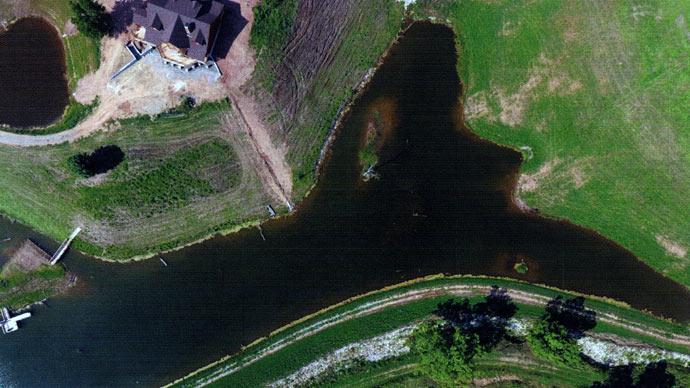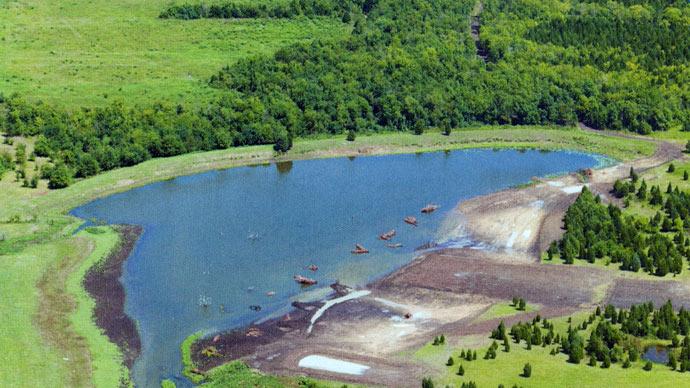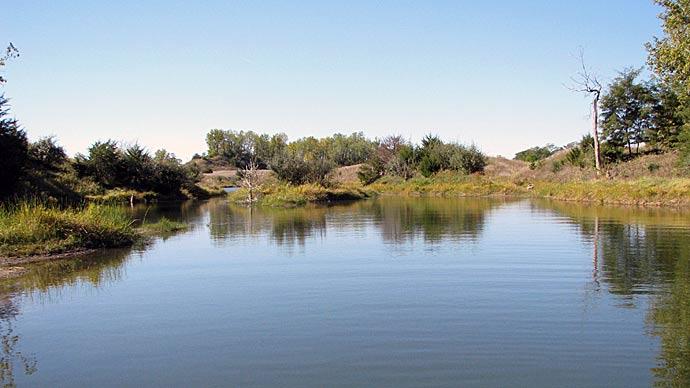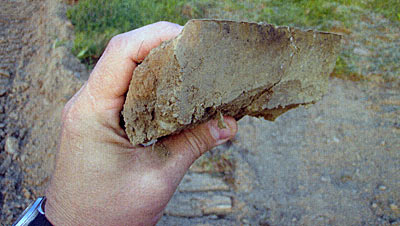
Many of my stories start with the phone ringing. The caller on the other end is looking for pond advice. Their problems can usually be lumped into a person (1) building a pond, (2) with a pond in trouble, or (3) wanting to improve an existing pond. Let's spend some time on number one—before you dig. These construction questions are difficult for me to field. I know what needs to be done, but I am not the one doing earthmoving contracting work. The best advice I give a person who wants to build a new pond (or rehab an old one) is to hire someone reputable. Approach this hire like you are vetting a doctor to do heart surgery. Ask for a list of references and visit these ponds. If a contractor won't give references, this is not your pond builder. Remember, you get what you pay for!
Ask the pond builder specific questions. One basic question is, "How many ponds have you built?" And, "How many of those ponds leak." Ouch! Really? Ask about their failures? Yep, please do. There is as much to be learned in failure (maybe more) as there is in success. I asked this question of my pond builder Ed Nadeau, "Ed, how many of the ponds you've built leak?" His answer? "Only the ponds that I built for landowners that refused to listen to me and had me put a pond where there should not be a pond." Hmmm. He went on to tell me that during his early pond building days he would build against his better judgement, even if a landowner was advised the location was not ideal (like in cracked shale). He then said, "I won't do that anymore." The money is not worth the headache. I've had many conversations with Ed over the last 20 years. He is a maestro on a bulldozer. Here is a summary of his experience and thought process.
Much of the art of building a pond is seeing the pond in a location, and then, making sure that location is, in fact, where the pond SHOULD go. Ponds with a 3-5% slope are the least expensive to build. This slope is best, because excavated material is used to make the dikes/levees/dams of the pond. Since no material needs to be moved off-site, these types of ponds are cheapest to build. Borrow pit (totally excavated) or dugout ponds are some of the most expensive, because they go into the ground and have no dikes or levees. This means material needs to be trucked off-site, adding significant cost. With bulldozer time running at $150-200 per hour, and dump truck fees equally high, it makes sense to minimize the amount of material moved.
Before you start construction, dig test holes. Go around to all parts of the staked-out pond footprint and dig. You need clay for your core trench and dikes. Spending a few dollars now to make sure you have enough clay will save you a world of headache (and dollars) later.

Some contractors are too quick to start digging and they lose topsoil. Or worse yet, they put seams of topsoil into the dike. A good contractor will not mix topsoil with clay. Topsoil is too valuable to use in a dam, and more importantly, the quality of topsoil for dam building is poor. Topsoil grows things. Clay compacts, which is necessary when building a dike or a dam. Topsoil should be stripped from the construction area and windrowed along the outside of the pond's embankment. After the embankments are complete, the contractor should spread topsoil evenly, in a thin layer, over the top of the dike and the backside slope of the embankment. After the structural part is constructed, Ed says, "Topsoil should be spread thinly over the outside banks to keep ruts out when you mow. You want the final grade to be relatively hard. Muskrats like to burrow in softer soils and don't like hard compacted clay. I don't like to spread topsoil too thick; a few inches are plenty." I had never thought of the muskrat angle before. Add seed and mulch, and you are back to sod in no time. If your contractor loses your topsoil, then you'll have a tough time trying to get grass to grow. Save the topsoil.
You need a core trench. A core trench cuts off blind ditches, old tiles, veins of gravel or sand, and makes sure all material under the pond is clay. I was watching Ed work the dozer one evening and he stopped abruptly. He motioned for me to come over. Without turning off the dozer, he pointed to a curiously straight line of rocks extending half way across the pond bottom. What the heck? Ed hollered above the engine's roar, "Blind ditch!" Then he hollered, "Not good!" My heart sank. Then just before the dozer roared off he gave me a reassuring holler, "We gotta see if my core trench cut that off!" I watched him for the next 40 minutes follow (and rip apart) that blind ditch. My heart gave a little twinge of remorse at the thought off all the sweat that had gone into that ditch, hand dug in heavy, rocky soil 100 years ago by some poor farmer. The ditch was designed to drain excess water off a farm plot, like today's French drains. The dozer continued across the middle of the pond and bit into the dike. The blind ditch ended at the core trench! Two feet of hard-packed clay lies below the hand dug, rock-filled drain. Victory! Ed looked over at me and gave an approving nod as if to say, "I thought so, but I feel better that I checked." The entire excavation he just did was unnecessary, but had he not made sure, that one little ditch could have drained the entire pond, like the drain in a bathtub. "A core trench must be at least two feet lower than natural ground level and should be backfilled with homogenized clay, blended and compacted." In our area, Ed says this . .breaks up the natural sorting that the glaciers left behind." These layers can be water wicking sand and gravel that must be mixed with clay and compacted. "A good core trench does not have to be that wide, I have made them with my excavator. But I prefer to make them 10 feet wide, the width of my dozer blade."
Building a pond in a stream is a bad idea here. In other areas of the nation, it may be a great idea. In upstate NY, we have had two 100-year floods IN THE LAST FIVE YEARS! What does this mean? Plan for the worst. Here, we expect periodic flooding and lots of water, whether from snowmelt or rainfall. We are in an area that receives its fair share of snow. Impounding a stream means getting permits, building an engineered dam, and designing a concrete flood control structure that is erosion resistant (mother nature will win eventually), and capable of handling large amounts of water. This generally means lots of money. "It's against regulations," Ed says. "They wash out and they silt in." All reasons to keep away from the creek unless you have a plan to tackle these issues. But, don't expect Ed to help you. In his opinion and experience, your pond should fill like a bowl. Controlled water should come in, and controlled water will go out. A stream is not easily controllable.
Compacting clay is a specific process. The clay should be packed with at least two passes using a heavy tracked machine. Ed was using his 22-ton John Deere 850. "I like to go sideways and then lengthways as I compact." Other contractors prefer a sheepsfoot roller on six-inch lifts of clay for proper compaction. As I watched Ed build my dikes, I realized he wasted little motion with that hulking dozer. He would peel away layers of clay from the pond bottom. Then the dozer blade was raised slightly, depositing 4-6" of clay on the dike. He would then raise the blade all the way and run over the newly deposited material compacting it into the underlying layers, in lifts. "If you don't compact you'll end up with a dike that settles, and uneven ground. People who don't compact their dams are in trouble. Water will find a weak seam and follow it. Dry or moist material is better to compact than sloppy wet material. Didn't you see that wet stuff squishing out from under the dozer?" he asked, as though he were stating the obvious and I should have noticed. "Dry material is better with some moisture." Sometimes Ed brings in his excavator to dig out pockets and veins of gravel. "It's important to build the dam from the inside slope of the bank to the outside, and compact those layers as you work out. Compacting the outside of the dike is important too, or you'll get uneven ground out there, too."
My favorite expression from Ed was, "Don't wear out the dirt." He went on, "I know where I am going to push dirt before I do it. If you watch some people drive a dozer, they push dirt here and push dirt there. They don't have a plan. If you notice, rocks roll to the outside of my blade and will windrow. On the next pass I will straddle those wind rows and blend them in." This area of the country is loaded with round rocks ranging in size from gravel to softball size, with an occasional one as big as a basketball—a byproduct of glacial movement thousands of years ago. These are some of the finer points of driving a dozer I never thought about. "Those rocks and gravel will turn into trouble if they are not homogenized." And, "Don't 'slot doze' either." What? Ed shot me a look. "Slot doze. We are not digging a steep sided house foundation hole here, that's slot dozing. We need to dig a pond with blended, homogenized material." Mixing existing material with impervious clay will keep the pond holding water, and cut-off seams of gravel and sand. "Between most layers of clay are fine layers of sand," he said, pointing to pockets of water in what looked to me like a clay pond bottom. "See that? That water in the clay is perking up from the sand." Huh! No kidding, I thought. If water is coming IN, then with water pressure it can also go OUT. Hmmm. Mix in that clay!
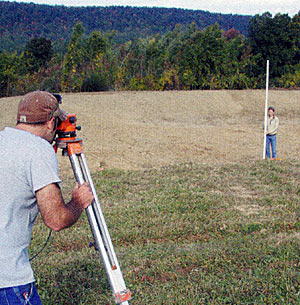
You should also calculate your slopes. "A good pond dam with a 3:1 slope, 10 feet high will be 70-75 feet wide at the bottom—that will hold back a lot of water. I like to build the tops of my dams at least 10 feet wide so you can drive around the pond and mow it easily. For every foot that you go down in depth, it brings the sides of the pond in 3 feet on a 3:1 slope. That shortens the width of the bottom at depth." With that he added, "I would not make a fish pond less than a quarter of an acre and never less than 8 feet deep. I don't build frog ponds.
"Don't build on too steep a slope. Some people want ponds on a side hill where there is a 9-10% slope. That's too steep. The bottom of the pond turns out being higher than the ground downhill from the dike." My eyes glazed over. "What?" I asked. I had followed everything he said up to that point. He said it again, but slower and with hand gestures. "On a steep slope you'll have a narrower pond that comes to a point at the bottom, and the bottom of that pond will be HIGHER than the original ground downhill from your dam." I got it that time. Bottom line here is that once you get your desired bottom depth it's time to come back up for the downhill dike. A long, narrow "V" shaped pond on the slope contour is what you get. Not too great.
"Some contractors say that they can build a 1-acre pond for $3,000. Well they are not doing it right then." He added, "Look, you can rent a dozer and try to do it yourself. That's when some people get in trouble." Ed then launched into a series of stories of good pond intentions gone bad. Hire someone who knows what they are doing, it will probably save you money and you'll end up with a better pond. He means it when he says, "I don't fix other people's mistakes." I will add to this—build your pond with a BIG heavy machine to compact the clay and move a lot of material on each pass. Man that dozer with someone that KNOWS how to drive it and how to move dirt.
"When I finish a pond and do the final grade, I track the dozer up and down the banks instead of along the side. Grass seed will stick in those cleat marks and won't run off in a rain." I had never thought of that before. It is kind of like contour farming. It breaks the speed and the erosion force of water. Seed and mulch those dikes ASAP. "Finish it off right."
After looking at many ponds that have failed, a few common themes emerge. Dam failure is usually a lack of size and mass (not big enough), not made of compacted clay (with a BIG machine), had a water control structure not sized for the watershed, or worse yet, has an emergency spillway over a structural part of the pond. Unless you install a concrete water control structure, your earthen emergency spillway should spill beyond and away from the backside slope of your dam.
Please visit a few ponds constructed by your contractor before they start work. See and ask if these things have been done correctly. Lastly, remember that you can dream all you want about your pond. You can build it in your mind's eye, sketch it out, plan it out—BUT REMEMBER— the person on the dozer builds the pond. Make sure your vision and reality match.
Reprinted with permission from Pond Boss Magazine

